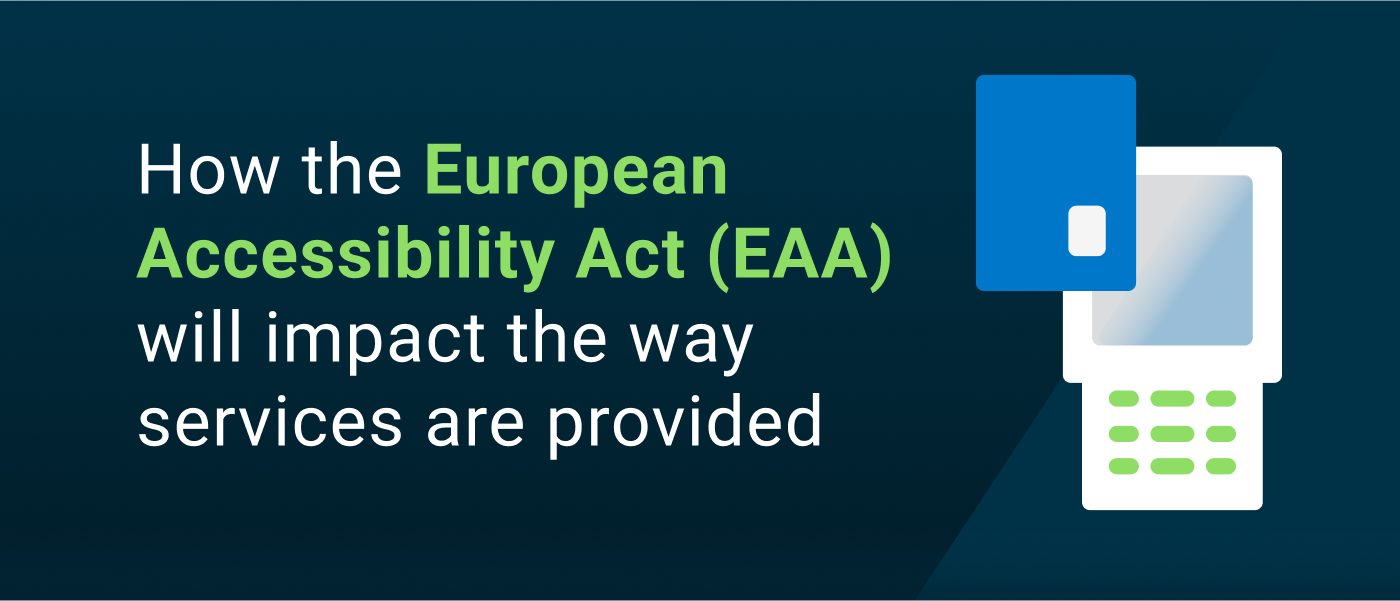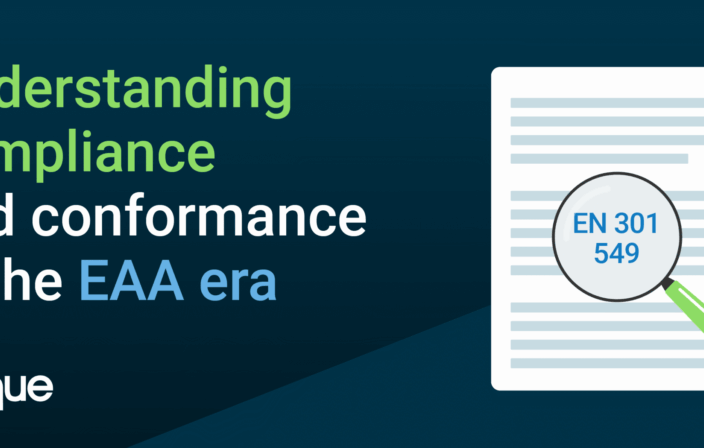Welcome to the third installment of our in-depth exploration of the European Accessibility Act (EAA). As we navigate the complexities, regulatory requirements, and potential impacts of this landmark act, our goal is to provide you with actionable guidance so your organization can drive the changes necessary to achieve EAA compliance.
Our first post in the series, An introduction to the European Accessibility Act (EAA), provided an overall look at the EAA’s scope, and in our follow-up, How the European Accessibility Act (EAA) will impact product accessibility, we took a deeper dive into the EAA’s impact on how products are offered.
In today’s post, we’ll delve into implications, risks, and strategies for service providers.
Services
The EAA significantly impacts how services are provided under its regulations. To maximize accessibility for individuals with disabilities, the EAA emphasizes providing information about the service’s operation and any products used in its delivery, ensuring compatibility with assistive technologies. This includes details about product accessibility features and their interactions with the service. Furthermore, the EAA mandates that service providers make their websites, online applications, and mobile-based services accessible.
General requirements related to services
Section III of Annex I outlines general accessibility requirements for all services covered by the directive, such as:
Information about the service
The directive emphasizes the importance of making information about the service and its accessibility readily available throughout provision of the service. This includes details about how it operates, information about the functioning of the service, any products used in its delivery, and specific accessibility features. This information should be presented in various formats to cater to different needs and be easily accessible to individuals with disabilities.
Note: While the directive doesn’t specifically describe promotional marketing websites in these general requirements, content within the sales funnel journey could be considered an aspect of the provision process of a service.
Compatibility and assistive technologies
Service providers are obligated to ensure compatibility with various assistive technologies that individuals with disabilities might use. This includes screen readers, alternative input devices, keyboard only navigation, and other tools facilitating access to digital content and functionalities.
Accessibility of digital platforms
A key requirement is ensuring the accessibility of websites, online applications, and mobile device-based services. These platforms, particularly those within the categories detailed in the following sections, should be designed and developed in a way that makes them perceivable, operable, understandable, and robust for users with disabilities.
Accessible support services
The directive also highlights the need for accessible communication channels for support services related to the provided e-commerce services. This encompasses making help desks, customer support, training materials, self-serve complaint and problem reporting, user journey flows, and other resources accessible to ensure individuals with disabilities can easily seek assistance and information.
Television and streaming services
Television and Streaming Services, particularly those offering features such as subtitles, audio descriptions, and sign language interpretation, are considered “services providing access to audiovisual media services.” The EAA emphasizes the importance of providing information about the accessibility of television and streaming services clearly and accessibly.
The directive mandates that these services, along with their associated consumer terminal equipment like smart TVs and streaming devices, must adhere to specific accessibility standards.
E-commerce services
The EAA defines “e-commerce services” as services provided at a distance through websites and mobile device-based services. These services are initiated electronically at the request of a consumer and aim to facilitate a consumer contract. The directive clarifies the following:
- “At a distance” implies the service is delivered without both parties physically present.
- “By electronic means” signifies electronic equipment is used for the initial transmission and reception of the service.
- “At the individual request of a consumer” means the service is provided upon individual demand.
Broad applicability of “e-commerce”
The EAA’s definition of “e-commerce services” is expansive, encompassing “services provided at a distance, through websites and mobile device-based services by electronic means and at the individual request of a consumer with a view to concluding a consumer contract.”
This definition would be applicable to almost any type of website or mobile application facilitating almost any kind of transaction. Examples include:
- Purchasing goods in an online store
- Bidding on an item through an auction site
- Booking accommodations
- Signing a utility contract or paying a bill
- Enrolling in a course or training program
Information accessibility is crucial
Regardless of the specific type of e-commerce service, the EAA emphasizes making service content accessible to users with disabilities. For instance, product descriptions, auction details, reservation systems, course information, and contract terms should all be designed and presented to be perceivable, operable, and understandable to individuals with varying abilities.
Core functionalities must be accessible
The EAA’s focus on compatibility with assistive technologies is particularly relevant. Because of this, some core functionalities have been called out in more detail and may need some special scrutiny. For example:
- E-commerce sites: Users relying on screen readers should be able to navigate product listings, input payment details, and complete purchases.
- Auction sites: Bidding mechanisms must be accessible, potentially requiring alternative input methods or text-to-speech functionalities.
- Transportation Services: Booking platforms for flights, trains, and other transportation must ensure individuals with disabilities can access and use reservation systems effectively.
Banking services
The EAA directly addresses the accessibility of consumer banking services as a key area of focus. And defines “consumer banking services” to include:
- Credit agreements: This encompasses consumer credit products and extends to products like personal loans and mortgages.
- Investment and insurance services: The directive incorporates various financial services, including investment services, portfolio management, investment advice, insurance-based investment products, and more.
- Payment services: Services such as executing payment transactions, operating payment accounts, and money remittance.
- Payment accounts: Services that are linked (or associated), such as access to checking account information, account switching, and access to basic account features, are considered to be in scope.
- Electronic money: The directive covers electronic money services, which includes issuing electronic money. This is relevant to aspects like pre-paid cards and digital wallets.
Key accessibility requirements for banking services
The directive sets out overarching accessibility obligations that apply across consumer banking. Here’s a breakdown:
Perceivable, Operable, Understandable, Robust
The EAA mandates that consumer banking services, including their digital interfaces (websites and mobile applications), must adhere to the four principles of accessibility known as POUR:
- Perceivable: Users must be able to perceive the information being presented (it can’t be invisible to all of their senses).
- Operable: Users must be able to operate the interface (the interface cannot require interaction that a user cannot perform)
- Understandable: Users must be able to understand the information as well as the operation of the user interface (the content or operation cannot be beyond their understanding)
- Robust: Users must be able to access content robust enough that it can be interpreted reliably by a wide variety of user agents, including assistive technologies, and the content should remain accessible even as technologies advance.
Accessible identification and security
Identification methods, electronic signatures, security features, and payment services within consumer banking must also comply with these four accessibility principles.
Example: A bank’s online platform should enable a blind customer to use their own assistive technology like a screen reader to navigate authentication steps, electronically sign documents, and authorize transactions securely.
Understandable information
The EAA emphasizes that information provided in consumer banking services must be understandable, adhering to a specific language complexity level (Level B2 — upper-intermediate) defined by the Council of Europe’s Common European Framework of Reference for Languages.
Example: This could mean presenting financial product terms and conditions in a clear and concise manner, avoiding jargon or overly technical language that could be challenging for some users to understand.
Passenger Transport Services
For passenger transport services by plane, bus, train, and water, there is existing EU law relating to passenger rights that already covers some aspects of accessibility in transport. The directive builds upon these existing regulations, introducing additional requirements to further enhance accessibility for all passengers. The EAA highlights several key areas where accessibility should be improved.
Websites and mobile applications
Operators of these transport services are obligated to make their websites and mobile apps accessible, ensuring individuals with disabilities can easily access information, book tickets, and manage their travel arrangements.
Electronic ticketing
Electronic tickets and electronic ticketing services must be designed with accessibility in mind, allowing passengers with disabilities to purchase and use tickets independently.
- Electronic tickets are systems where the right to travel, in the form of single or multiple travel tickets, travel subscriptions, or travel credit, is stored electronically on a physical transport pass or other devices rather than a paper ticket.
- Electronic ticketing services are systems where passengers buy tickets, including online using an interactive computing device. Tickets are delivered electronically so they can be printed or shown on an interactive mobile device when traveling.
Real-time travel information
This encompasses providing accessible real-time travel information through various channels, including websites, mobile apps, and interactive information screens. This includes details like timetables, delays, platform changes, connecting services, and accessibility features of vehicles and infrastructure. Delivery of this real-time travel information should maximize its use by persons with disabilities.
Interactive self-service terminals
Interactive self-service terminals located within the EU and used for passenger transport services must comply with accessibility requirements. These terminals are often used for purchasing tickets, checking in for travel, and accessing travel information.
Conclusion
The implementation of the EAA presents challenges and opportunities for both product and service providers, and while it represents a powerful shift toward societal inclusivity, there are very real regulatory and legal implications that businesses need to address in order to achieve compliance and avoid risk.
The European Accessibility Act (EAA) is now transposed into national law in most EU member states and will come into effect on June 28, 2025. If you’re an EU-based organization or do business within the EU, Deque can help ensure you meet EAA requirements:
- Get in touch with your local Deque team
- Measure current compliance with an accessibility audit
- Create a strategic roadmap with industry experts
- Catch accessibility issues for free with axe DevTools browser extension
Choose Deque as your EAA compliance partner, and together, we can help create a world where everyone can thrive.
Additional resources
Read answers from our experts to many of the most important EAA questions here:
European Accessibility Act (EAA): Top 20 Key Questions Answered
Watch our recent EAA webinar, please visit:
Countdown to enforcement 2025: Navigating the European Accessibility Act
Find official language of the directive here:
European Accessibility ACT (EAA)
Sections of the EAA referenced in this post include:




